Greek Dolmades, Stuffed Grape Leaves
July 08, 2019 | Updated July 17, 2020
As an Amazon Associate I earn from qualifying purchases.
Every year, in early summer, I think about making Greek dolmades, also known as stuffed grape leaves. Dolmades are one of the best vehicles for all sorts of tasty fillings, and there are versions of stuffed grape leaves all over the Mediterranean.
The reason is because wine grapes grow all over the area, and, when you grow grapes of any kind, you have excess vines and leaves from each year’s new growth. As you trim your vines, you save the leaves to make stuffed grape leaves fresh, or you preserve them for later.
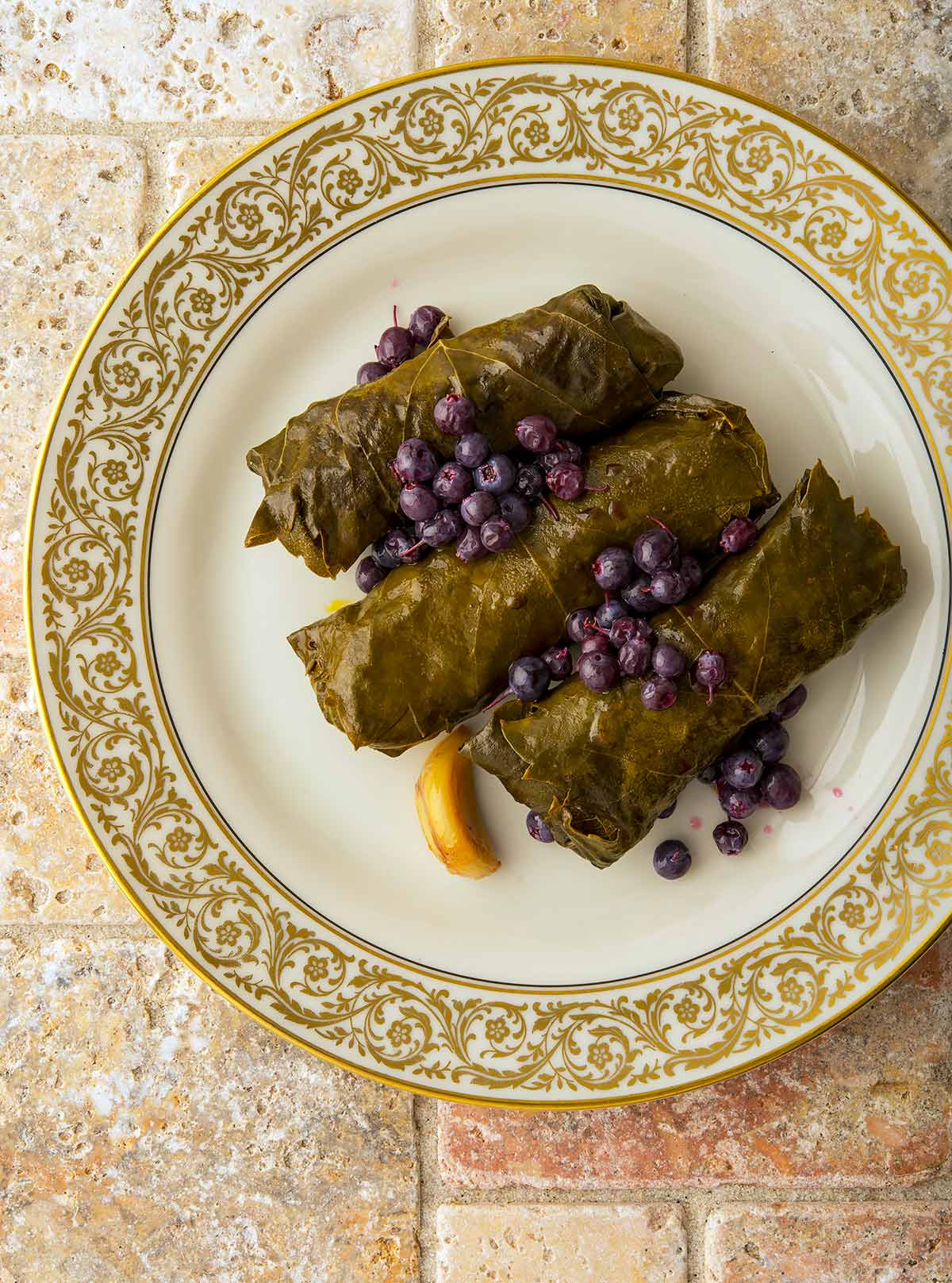
Incidentally, here is my method for preserved grape leaves. And you can of course buy preserved grape leaves, which is what most people do.
Greek Dolmades made with fresh leaves are better than those made with canned ones, so it might be worth it to see if any grapes live near you. Wild grape leaves are perfectly good to use, and some species kick out huge leaves perfect for stuffing.
What to stuff in your grape leaves? Really whatever you want. I’ve seen recipes for bulgur wheat fillings, ground meat, pumpkin, fish, mushrooms, and, most often, rice. This recipe is for vegetarian, rice-and-herb stuffed grape leaves.
Why? Because I like snacking on cold or room temperature dolmades. And meat or fish filled grape leaves aren’t terribly good cold. The general rule with this sort of stuffed grape leaves is to mix the rice with lots of fresh herbs, as well as something else to make it interesting. Sometimes small berries or bits of fruit, sometimes nuts, sometimes a bit of different vegetables.
INGREDIENTS
The Persian stuffed grape leaves I get at my local restaurant always have semi-dried barberries on them, little bright bursts of tart-sweetness. I don’t happen to have any, but I do have dried Sierra Nevada blueberries, which are much smaller than store-bought, and dry to a leathery consistency well.

You can use any small, tart berry. Other good choices would be lingonberries, other small wild blueberries, red huckleberries, agarita berries, and, of course, actual barberries.
The herb choice is also up to you. I used mountain pennyroyal, a local species of “wild oregano,” as well as parsley and chives from the yard. In general, you want a mint-like thing, an oregano-like thing, and a chive-like thing. And it’s always good to add parsley. You have all sorts of choices depending on where you live.
A word on the rice. You absolutely must use medium- or short-grain rice if you want to eat your stuffed grape leaves cold. Cold long-grain rice, which is the most common rice sold in the United States, will taste like cardboard nails in your mouth if you eat it cold. Look for sushi rice or arborio instead.
MAKING GREEK DOLMADES
Now, on to making your stuffed grape leaves. It’s easy, but there is a bit of a system you need to learn first. It should only take you a few leaves to get it down.
First, you will mix your uncooked rice with everything else. Yes, uncooked. The rice gets cooked later, when your dolmades are all made. Have that nearby.
If you are using fresh grape leaves, boil them first for about 2 minutes, so they turn army green and soften. If you are using canned, just carefully take them out of the jar or can and unfold them. Preserve grape leaves are more fragile than fresh ones.
Don’t toss any ripped leaves! You will use them to line the pot you cook the dolmades in.
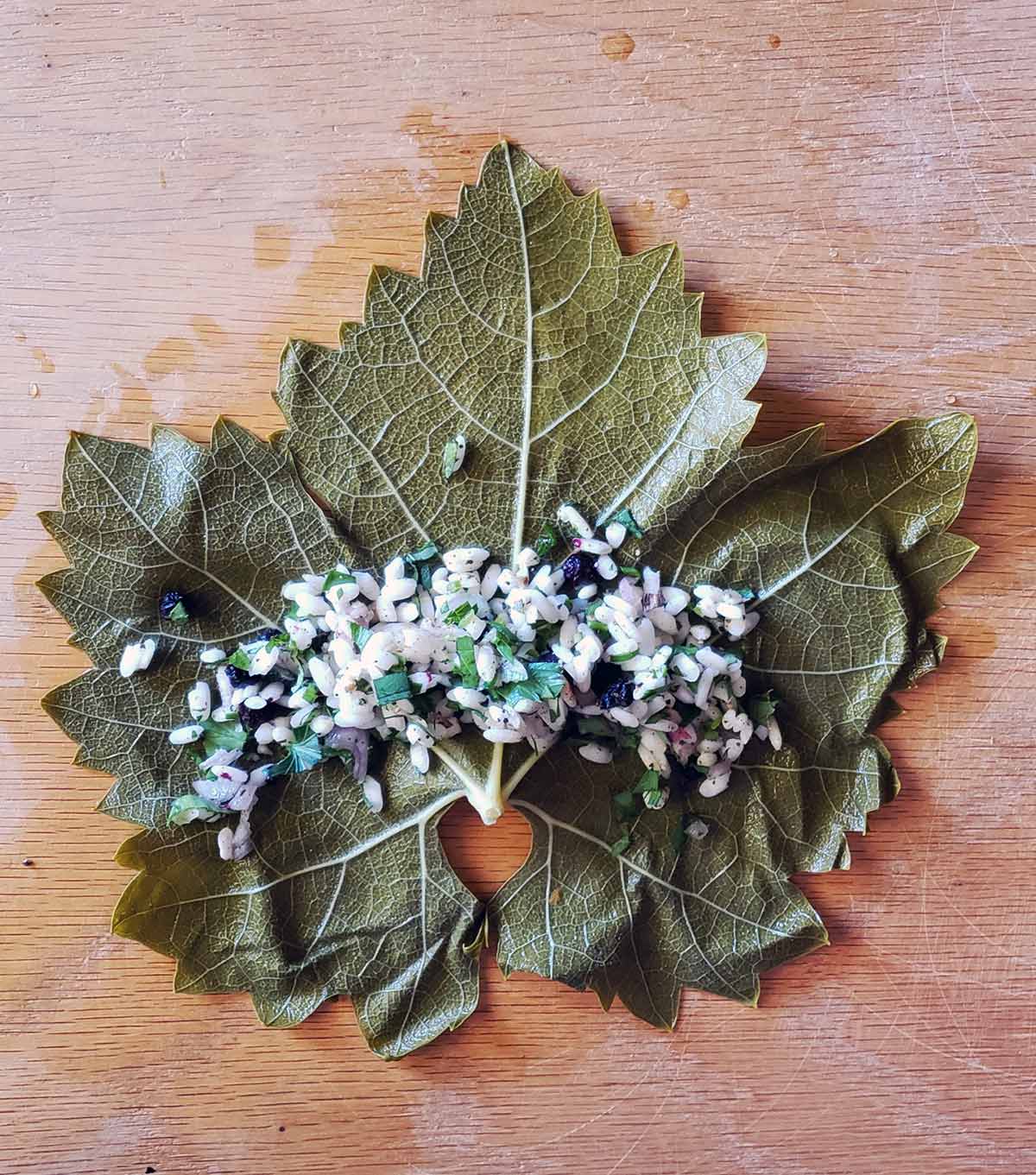
Lay a grape leaf vein side up, facing away from you. Spoon some mixture onto the leaf. How much? Usually about a tablespoon, but your leaves will all be different sizes.
Fold the bottom of the leaf up over the filling, then fold in the sides — this is basically the same as folding a burrito. Tightly roll the grape leaf up toward the point, then set it, seam side down, into your pot lined with grape leaves. Repeat until you’ve used all your filling.
We did a little video on how to stuff grape leaves here.
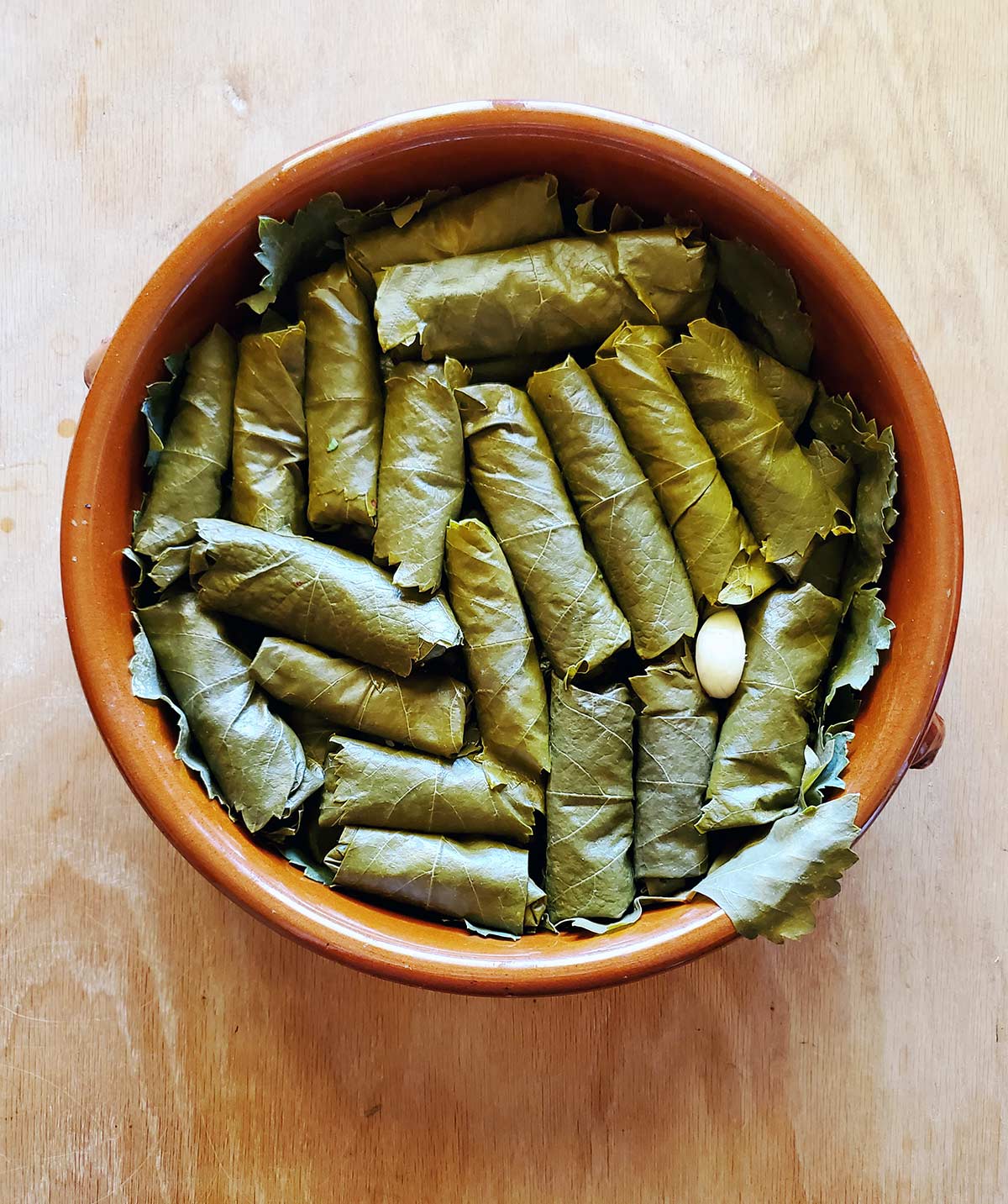
COOKING AND EATING STUFFED GRAPE LEAVES
You cook your stuffed grape leaves by adding water, olive oil and lemon juice, then simmering them until the rice has absorbed all the water. Let them cool in the pot to absorb any excess water or steam, then serve hot at first, then cool thereafter.
Once made, dolmades will keep for a week or more in the fridge.
Greek Dolmades
Ingredients
- Roughly 50 grape leaves
- 1 1/2 cups short- or medium-grain rice, such as sushi or arborio
- 2 shallots, minced
- 2 garlic cloves, minced
- 2 tablespoons minced fresh parsley
- 2 tablespoons minced fresh mint
- 2 tablespoons minced fresh chives
- 1/2 teaspoon ground allspice
- 1/2 teaspoon ground coriander
- 1/2 teaspoon ground cinnamon
- 3 tablespoons dried tart berries (optional)
- Salt and black pepper
- 2/3 cup olive oil
- 1 teaspoon sugar
- 2 lemons, zest grated and juiced
Instructions
- Pour boiling water over the rice and stir well until the water is milky. Drain the rice and rinse it well. Add the shallots, garlic, parsley, mint, chives, allspice, coriander, cinnamon and the berries, if you are using them. If you are zesting the lemons, add the grated zest, too. Mix well and set in a bowl.
- Line a shallow pot with grape leaves; this prevents the stuffed grape leaves from sticking to the pot. Stuff the grape leaves as described above, tucking them in snugly into the pot. If you have gaps, it's nice to put in a garlic clove, which adds some flavor, and is tasty once cooked.
- Once you have all the grape leaves in the pot -- and it is perfectly OK to add them in layers -- dissolve enough salt into 2 cups of water to make it salty, about a tablespoon, and then dissolve the sugar in the water. Pour this over the stuffed grape leaves. Then pour over the olive oil and the lemon juice.
- Set a plate over the dolmades so they don't unravel during cooking. Cover the pot and bring to a gentle simmer. Cook this way for 50 minutes. Turn off the heat and wait at least 20 minutes before eating. If you want, spoon some pickled berries over your stuffed grape leaves when you serve them.
Video
Nutrition
Nutrition information is automatically calculated, so should only be used as an approximation.

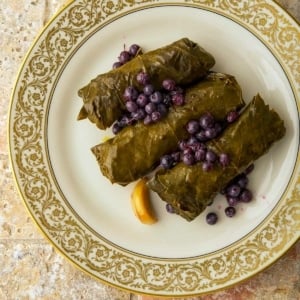



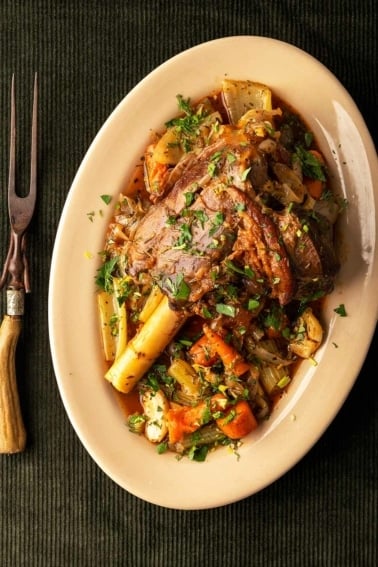
Hey Hank, I do this recipe annually (since you posted it) to celebrate summer. I tell my friends that I grow the grapes more for the leaves than the fruit. It is true on reflection. Thanks for the recipe!
Point of clarification, Hank; not lengthwise, as in, “Spoon some mixture onto the leaf, lengthwise.” The pic indicates widthwise and that is correct. Just sayin’.
Delish! Used dr cranberries, goji berries (really could have used tarter berries) and beet leaves instead of listed ingreds and SO delish!
Thanks hank!
Thank you for this recipe! I’ve been wanting to make them for years. Used grape leaves from my backyard, and red currant berries from up the road. I’m so happy I’ve found your site!
I’m also going to try sauteeing day lilies from the garden, and harvested some hazelnuts too. Last time I did that they were full of filbert worms, so I’m hoping I got them early enough this time!
Made these today with leaves from the wild grapes that grow in our woods. Didn’t add any berries, though. Tried one hot out of the pot. Wow, are these good! Can’t wait to eat them cold. Thanks, Hank, for another excellent recipe!
Hi Hank, thanks for responding.
Just to be clear, I’m asking about freezing the Dolmades themselves, not the fresh grape leaves.
I have frozen (blanched) grape leaves before, and I never really found them very successful for making Dolmades. Perhaps I left them in the freezer too long… maybe nine months? In any case, once I thawed them out, they were too fragile to use. I think preserving them in jars seems to work better.
But perhaps I’ve answered my own question: is the leaves themselves become very fragile after being frozen and thawed out, maybe the Dolmades would also be fragile after thawing?
I have a big family dinner a week from now, and I’m trying to do a much ahead of time as possible. Maybe I should just wait a few more days to do the Dolmades.
BTW, I picked up “Duck, Duck, Goose” not that long ago. I love it. Duck and goose are about my favourite things ever. 😉
Allan: Ah, gotchya. They keep for more than a week in the fridge, so you can make them well ahead.
You say the grape leaves will keep for up to a week; do you think they’d freeze well?
Allan: They do freeze well, but once frozen they are very brittle, so you have to keep them safe from shattering in the freezer.
Love dolmades. I saw this recipe and got some grape leaves from my folks’ vine. I used arborio rice, mixed in a little carrot, garlic, red onion, black bean, fresh chives, fresh thyme, fresh basil, ground allspice, cinnamon, and zest from 1 lemon.
They came out fantastic. I had them as a side to Hank’s Tunesian deer Shanks.
Awesome recipe as usual, Hank. I’ve been making dolmades for several years (as there’s loads of wild and cultivated grapes here in northern Michigan). I typically stuff them with ground venison and rice, usually seasoned with mint and/or dill, and sometimes with dried berries of some type. Delicious with or without avoglomeno sauce. They’ve become a summertime staple (great on a mezze platter accompanied with homemade hummus, pita, etc.). They freeze well so I usually cook up a big batch.
This post was perfectly timed! My husband has been craving stuffed grape leaves for 2 weeks & I couldn’t find my recipe. Thank you!
I look forward to trying your loukaniko sausage recipe too.
I loved your linguica recipe, btw. So did all my friends!
I’m interested in substituting other grains like quinoa, freekeh, barley, etc. I assume that the variation would require a change to the boiling time, as the grain is raw to begin with, but all else the same? Thanks Hank. I have fresh grape leaves in the backyard talking to me now :-).
Val: Some of those might be tough. Pearled barley you could do with this recipe. Freekeh would take longer, but I am not sure about the water amount, and I have no real experience cooking quinoa. If you nail down some amounts and times, can you post back here? I’d love to know.
This is the most innovative cooking site I know. Haven’t tried the recipe yet, but I certainly will.
Hi, Mr Hank, that sounds so good! I want to try it as soon as I can. I have a question: could I use scuppernong grape leaves or muscadine grape leaves for this if I can get a friend mine to trim some young leaves off her vines? Thanks very much!
Jacqueline: Absolutely! You’ll want the largest leaves from those vines.
Yay, Hank, you’re on my wavelength! First attempt on this for me. I’m onto foraging sources for the leaves and mint, and the Oregon grape in my own yard are coming ripe. Just discovered the “mallow,” Matva parviflora, previously known to me as buttonweed, and the chickweed on my ground are edible. Dare I use the years-old arborio I can hunt down in my pantry?
Marilyn: Go for it, but I’d soak the rice for maybe an hour first.
Excellent!
I just learned yesterday from my Lebanese friend, that picking grape leaves early in the season, well before grapes begin to show, makes all the difference in the texture and delicate-ness of the dolmades.
Hello Hank,
Love your posts.
I am really into jarring and preserving so what would the instructions be if I wanted to preserve some jars of these tasty stuffed grape leaves? Can in vinegar, olive oil or both?
How long of a hot bath, etc.
Thanks
Deborah: I have no idea. I do know that you cannot water-bath can a stuffed grape leaf. You could get botulism.
Hi Hank – I’m so pleased you’ve written this up. A few years ago, we were in northern Greece, and the beautiful server at the taverna we ate at most days help us pass a rainy afternoon by showing us how to make dolmades. Like you, she put tons of green stuff in; the more the better. She even added shredded leftover romaine lettuce. The problem was I didn’t write it down, and I could never remember the correct proportion of water to rice. And we did once make it with long grain rice. Blech. We’re going to make some today, with the grape leaves that grow in the alley behind our house!
What a grape time of year for vine leaf recipes
William: Now. Early to midsummer with fresh ones.